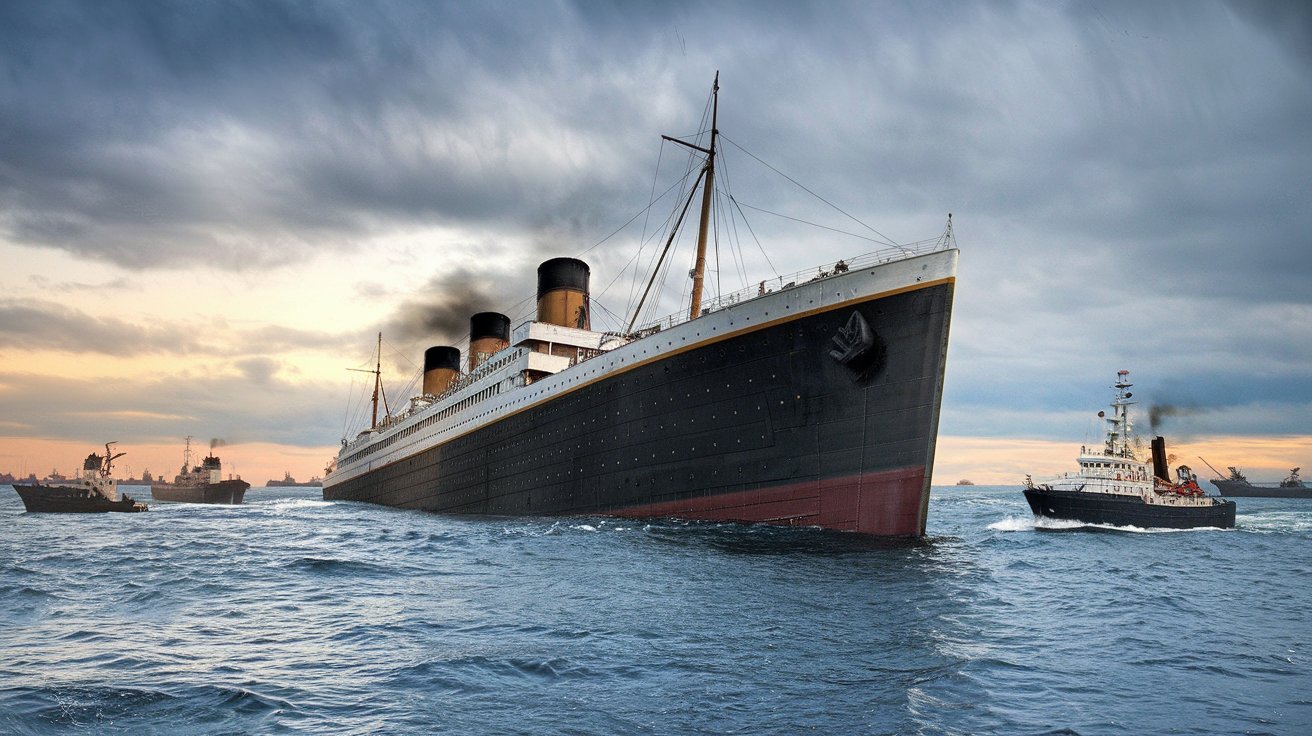
Have you ever imagined what the Titanic looked like in color? The RMS Titanic, often called the "unsinkable ship," was a marvel of engineering and luxury in its time. Built by Harland and Wolff in Belfast, Ireland, this grand vessel was commissioned by the British shipping company White Star Line. The Titanic's story is filled with fascinating details, from its construction and opulent amenities to its tragic sinking and enduring legacy. Through 35 key facts, we'll explore the vibrant history of the Titanic, shedding light on its grandeur, the fateful maiden voyage, and the remarkable artifacts that have been recovered from its wreckage.
Construction and Launch
The RMS Titanic, often called the "unsinkable ship," was a marvel of its time. Its construction and launch were feats of engineering and human effort.
- Construction began in 1909 and took three years to complete, finishing in 1912. The project cost $7.5 million, which is about $200 million today.
- Around 3,000 workers were involved in building the Titanic at the Harland and Wolff shipyard in Belfast, Ireland.
- The ship measured 882 feet in length and 92 feet in width, making it the largest moving, man-made object in the world at that time.
- Before its launch, the Titanic was lubricated with 20 tons of animal fat and soap to help it slide smoothly into the water.
Luxurious Amenities
The Titanic was not just an engineering marvel; it was also a floating palace. The ship offered numerous luxurious amenities designed to cater to its first-class passengers.
- The ship featured a swimming pool, gymnasium, Turkish baths, and even a dog kennel.
- Despite its opulence, the Titanic had only 20 lifeboats, enough for about half of the people on board.
Maiden Voyage
The Titanic's maiden voyage was meant to showcase its grandeur and luxury. However, it ended in tragedy.
- The ship set sail from Southampton, England, on April 10, 1912, making stops at Cherbourg in France and Queenstown in Ireland before heading to New York City.
- On the night of April 14, 1912, the Titanic struck an iceberg in the North Atlantic Ocean, causing significant damage to its hull.
- The ship sank in the early hours of April 15, 1912, leading to the loss of over 1,500 lives out of the approximately 2,200 people on board.
Rescue Efforts and Discovery
Despite the tragedy, rescue efforts and the eventual discovery of the wreckage have kept the Titanic's story alive.
- The RMS Carpathia arrived at the scene around 3:30 AM on April 15, rescuing around 705 survivors.
- The wreckage was discovered on September 1, 1985, by oceanographer Robert Ballard and scientist Jean-Louis Michel.
- Despite being submerged for over 70 years, the wreckage was remarkably well-preserved due to the cold, dark environment.
Artifacts and Preservation
Artifacts recovered from the Titanic provide valuable insights into the lives of its passengers and crew.
- Over 5,000 artifacts have been recovered, including jewelry, musical instruments, and pieces of the ship itself.
- One of the most poignant artifacts is the ship's band instruments. The band played music on the deck as the ship sank.
- Efforts have been made to preserve the wreckage and artifacts, with the site protected by international law to prevent further damage or looting.
Remarkable Survival Stories
The Titanic's sinking led to many remarkable survival stories, highlighting human resilience in the face of tragedy.
- Charles Lightoller, the ship's second officer, survived by clinging to a liferaft and later helped other survivors board the Carpathia.
- Charles Joughin, the chief baker, survived by fortifying himself with schnapps, which likely helped him stay warm and alert.
- Six Chinese men survived the sinking but were not allowed into the USA due to immigration laws.
- Three little dogs also survived the disaster, adding to the poignant tales of survival and loss.
Historical Significance and Legacy
The Titanic's story has captivated the public for over a century, serving as a cautionary tale about hubris, safety protocols, and human error.
- The sinking marked a turning point in maritime history, leading to significant changes in safety regulations and emergency procedures for ships at sea.
- Museums around the world have dedicated exhibitions to the Titanic, showcasing artifacts and stories of the passengers and crew.
- The Titanic has been the subject of numerous documentaries, films, and books, with James Cameron's 1997 film being the most famous adaptation.
- Public fascination with the Titanic continues to this day, ensuring its place in history for generations to come.
Interesting Tidbits
The Titanic's story is filled with interesting tidbits that add depth to its legacy.
- The first film about the Titanic, "Saved From the Titanic," was released just 31 days after the sinking.
- Despite numerous claims, there are no known photos of the Titanic's grand staircase. Photos of its sister ship, the Olympic, were often used instead.
- Arthur John Priest, a stoker, survived five shipwrecks, including the Titanic and its sister ship, the Britannic.
- The Titanic had its own cat, which survived the disaster.
- The Olympic, the Titanic's sister ship, attempted to aid in the rescue efforts but was 100 miles away.
Technological and Scientific Insights
The Titanic's construction, sinking, and subsequent discovery have provided valuable technological and scientific insights.
- The iceberg collision did not cause a huge gash in the ship's hull. Instead, it caused the seams to split, leading to flooding.
- Robert Ballard's discovery of the wreckage was a groundbreaking moment in maritime history, with his team taking over 60,000 photos and hours of video footage.
- The Titanic burned a significant amount of coal during its journey, resulting in around 110 tons of ash being dumped into the Atlantic Ocean every day.
Cultural Impact
The Titanic's story has had a lasting impact on culture, inspiring countless works of art, literature, and media.
- The Titanic's band played music on the deck as the ship sank, providing a sense of hope and resilience.
- The story bears eerie similarities to an 1889 novel called "The Wreck of the Titan, or, Futility" by Morgan Robertson, which predicted many details of the Titanic's fate.
- Museums and exhibitions dedicated to the Titanic serve as a tribute to those who lost their lives and provide a historical perspective on the tragedy.
- The Titanic's legacy extends beyond its tragic fate, serving as a reminder of human ingenuity, luxury, and the importance of safety protocols.
Titanic's Enduring Fascination
The Titanic remains a symbol of human ambition and tragedy. Its construction, luxurious amenities, and tragic sinking continue to captivate people worldwide. From the grand staircase to the heroic band, every detail of the ship's story adds to its mystique. The discovery of the wreckage and the preservation of artifacts have kept the memory alive, offering glimpses into the lives of those on board. The safety oversights and heroic survival stories remind us of the importance of preparedness and resilience. Museums, films, and documentaries ensure that the Titanic's legacy endures, teaching valuable lessons about human ingenuity and fallibility. The ship's tale, rich in both grandeur and sorrow, continues to be a poignant reminder of the past, ensuring its place in history for generations to come.
Was this page helpful?
Our commitment to delivering trustworthy and engaging content is at the heart of what we do. Each fact on our site is contributed by real users like you, bringing a wealth of diverse insights and information. To ensure the highest standards of accuracy and reliability, our dedicated editors meticulously review each submission. This process guarantees that the facts we share are not only fascinating but also credible. Trust in our commitment to quality and authenticity as you explore and learn with us.


